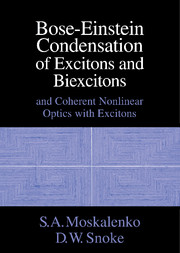Book contents
- Frontmatter
- Contents
- Preface
- 1 Introduction
- 2 Basic Theory of Bose–Einstein Condensation of Excitons
- 3 The Interaction of Condensed Excitons with Lattice Phonons
- 4 Bose–Einstein Condensation of Biexcitons
- 5 Phase Transitions and Thermodynamics of High-Density of Excitons
- 6 The Optical Stark Effect and the Virtual Bose Condensate
- 7 Bose–Einstein Condensation of Mixed States of Excitons and Photons
- 8 Nonequilibrium Kinetics of High-Density Excitons
- 9 Coherent Nonlinear Optics with Excitons
- 10 New Directions
- Appendix A: Properties of Excitons in Cu2O
- Author Index
- Subject Index
4 - Bose–Einstein Condensation of Biexcitons
Published online by Cambridge University Press: 04 August 2010
- Frontmatter
- Contents
- Preface
- 1 Introduction
- 2 Basic Theory of Bose–Einstein Condensation of Excitons
- 3 The Interaction of Condensed Excitons with Lattice Phonons
- 4 Bose–Einstein Condensation of Biexcitons
- 5 Phase Transitions and Thermodynamics of High-Density of Excitons
- 6 The Optical Stark Effect and the Virtual Bose Condensate
- 7 Bose–Einstein Condensation of Mixed States of Excitons and Photons
- 8 Nonequilibrium Kinetics of High-Density Excitons
- 9 Coherent Nonlinear Optics with Excitons
- 10 New Directions
- Appendix A: Properties of Excitons in Cu2O
- Author Index
- Subject Index
Summary
Biexcitons and Exciton-Exciton Interactions in Semiconductors
The concept of the excitonic molecule was introduced independently by Moskalenko [1] and Lampert [2]; later, the excitonic molecule was called the biexciton [3]. The biexciton represents the bound state of four Fermi quasiparticles, namely two electrons and two holes. More simply, it can be regarded as a bound state of two excitons.
Besides biexcitons, one can in general talk about “trions” and “quaternions,” which are bound states of any combination of three or four electrons and holes, respectively. A trion always carries charge; a quaternion may or may not have charge, biexcitons being one kind of quaternion. Several different types of trions and quaternions are expected to be stable in semiconductors in both bulk and two-dimensional (2D) structures; later in this chapter we discuss a proposal [4] for superconductivity based on charged quatemionic bound states of electrons and holes.
Since biexcitons are also integer-spin bosons, they are expected to obey the same Bose statistics as excitons, including Bose narrowing of the energy distribution, discussed in Chapter 1. This has been seen in the semiconductor CuCl. We review experiments on Bose effects of biexcitons in CuCl at the end of this chapter.
We have already briefly discussed the exciton-exciton interaction in Subsection 2.1.3 in terms of the estimate of the s-wave-scattering length that goes into models of the weakly interacting Bose gas. As we mentioned there, this interaction is essentially a van der Waals force, but with the additional complications of comparable electron and hole masses and electron-hole exchange. In this section, we treat this interaction in greater detail, since it determines whether excitonic molecules and/or electron-hole liquids (EHLs) can form.
- Type
- Chapter
- Information
- Bose-Einstein Condensation of Excitons and BiexcitonsAnd Coherent Nonlinear Optics with Excitons, pp. 123 - 165Publisher: Cambridge University PressPrint publication year: 2000
- 1
- Cited by



